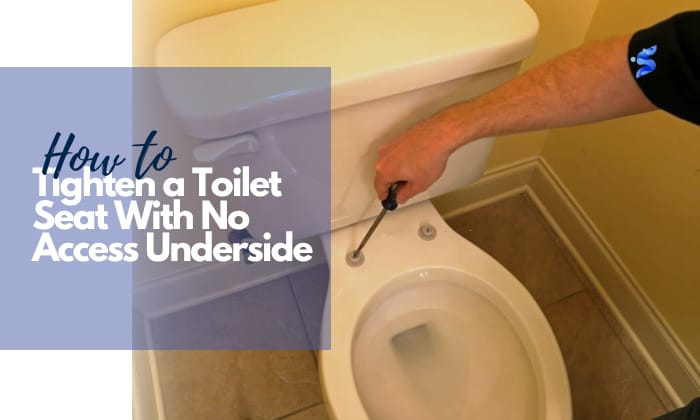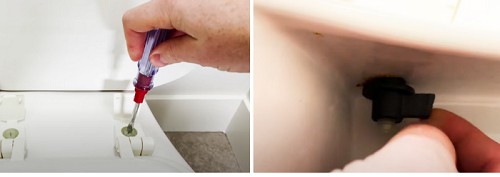A toilet seat loosening over time is normal, especially when you don’t use it properly, or you have extra movements when you sit. This shouldn’t be something to worry about because the bolts can be adjusted easily.
But what if you have a toilet with hidden fixings?
Continue reading to learn how to tighten toilet seat with no access underside, so you won’t wobble when you use the loo!
Table of Contents
Ways to Tighten Toilet Seat With No Underside Access
There are different reasons why toilet seats become loose or won’t stay tight, and some of them are the following:
- leaning forward while using the toilet, which causes the back part to rise;
- standing on the toilet;
- repeatedly taking off (and installing) the seat when cleaning;
- repetitively raising and lowering the seat and;
- natural wearing and tearing of the hinges through time.
You might panic if your toilet is relatively modern and appears to have no screws. Some seat models also have no buttons for release.
But don’t worry! Below are the steps to tighten hidden fixings that can help you.
Step 1: Determine the Type of the Toilet Fixings
Concealed types of toilet seat fixings are commonly top or bottom-fixed. From the names themselves, the top ones are tightened from the top, which may look like this:
On the other hand, bottom fixings have screws tightened under the toilet using a nut and washer.
It’s essential to know which is applicable to your commode so you can locate the screws easily and proceed to secure them.
Step 2: Remove the Toilet Seat (Top-fixed)
Modern toilet seats may or may not have release buttons that you can push to remove them from the commode, so we included instructions for both types.
- With Release Buttons
Simply push the chrome buttons on both sides to release the seat and lift it up.
- Without Release Buttons
Whether the seat is closed or opened, hold it tightly and pull it up with enough force for removal.
Take note that this is only for top hidden fixings since for bottom fixings, having the seat installed won’t hinder you from tightening the bolts. Below is an example to give you an idea:
This is a Kohler toilet with bottom fixings. The screws are hidden at the top by caps and it’s better to adjust them with the seat on, so you can immediately test if the tightness is enough.
Step 3: Adjust the Hidden Fixings
What you will need:
- gloves (optional but recommended)
- screwdriver (must be compatible with your bolts)
- adjustable wrench
Once you have removed the toilet seat, make sure to remove the cap covering the seat hinges. Follow the instructions below according to your type of fixings.
- Top Fixings
- With a compatible screwdriver, tighten the bolt from the top until secured.
- If you have to tighten an Ideal Standard toilet seat with top fixings, you can also follow these same steps. Most likely, you won’t have access to the commode’s underside.
- Install the seat back to the hinges and test if it wobbles.
- Bottom Fixings
- Grab a screwdriver to adjust the bolt from the top. You will also need to hold the nut and washer below the toilet or use an adjustable wrench for a tighter grip.
- If necessary, tighten the nut and washer below as well to ensure that everything is in place.
- Secure the bolts accordingly to stop the toilet seat from sliding sideways. We recommend sitting on it to test its stability.
Other Methods to Tighten the Toilet Seats
- Epoxy Resin
You can use epoxy resin on hinge sockets if you have worn-out and wobbly seat. Please note that you should clean those hinges first and let the epoxy sit for at least 24 hours before using the toilet again.
- Rubber washers
An excellent choice for a wobbly toilet seat is a rubber washer when it’s installed on top of your toilet’s hinge socket. These washers can ensure better attachment between the toilet seat and the bowl.
- Wing nuts
Look for the bolts underside of the toilet seat to find wing nuts at the base of the bolts. Then, use your gloved hand to tighten them, clock-wise.
Conclusion
Toilets nowadays have what we call “concealed” or hidden fixings. While these will improve the appearance of the commode, you will wonder how to tighten toilet seat with no access underside.
Fortunately, it’s not a hard task since seats become loose over time, making the hinges adjustable. For top fixings, we can tighten the bolt with a screwdriver. As for the bottom fixings, we have to tighten the screw from above while holding the nut that secures it under the toilet.
Related

I’m Paulk Webb, and I work as a writer for Saveourwaterrebates. I’m happy to put in the time and effort to conduct market research to identify the most pressing issues faced by households concerning their plumbing. Feel free to check out our guides to get the most informed recommendations for how to solve your problems.








